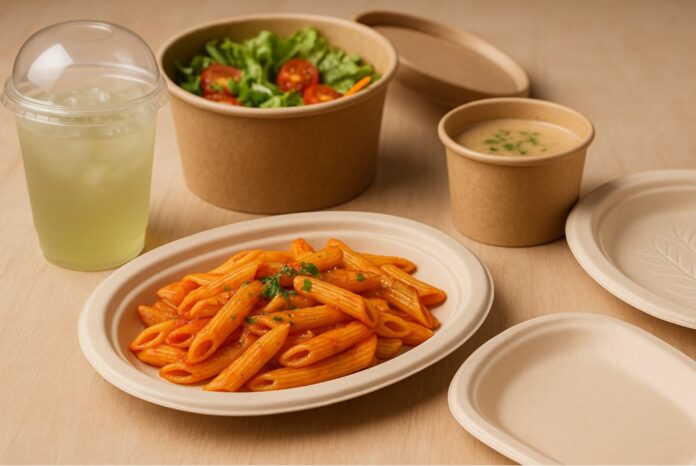“Should we get salads to go?” Anna asked, glancing at her colleague as they stepped out of their office in downtown New York.
“Sure,” replied James, “but let’s pick a place that doesn’t use plastic. I’d rather support businesses that serve in compostable containers.”
This small conversation mirrors a global consumer shift: people want their food not only fresh and delicious but also served in packaging that protects the planet. From salads and soups to full-course meals, eco-friendly containers are becoming the new standard for restaurants, cafés, and food factories.
Disposable Salad Containers: The First Step to Green Takeaway
According to a 2023 NielsenIQ report, 68% of global consumers actively look for brands using eco-friendly packaging, and over half are willing to pay more for sustainable options. For businesses, one of the simplest yet most impactful switches is using disposable salad containers.
Made from kraft paper, bagasse (sugarcane fiber), or PLA bioplastic, these containers are sturdy enough to handle dressings and toppings while being compostable after use. A case study from a Canadian salad bar chain found that replacing plastic bowls with compostable ones cut their landfill waste by 42% in just six months. Customers responded positively, with sales rising by nearly 10%.
Soup Cups With Lids: Balancing Functionality and Sustainability
Soups, stews, and ramen are notoriously difficult to package sustainably because of temperature and liquid resistance. But new solutions—especially soup cups with lids—have shown how functionality and eco-friendliness can coexist.
A 2024 study by the Food Packaging Forum revealed that aqueous-coated paper cups and bagasse containers safely hold hot liquids without leaching harmful chemicals. Restaurants using these compostable cups report not only reduced plastic waste but also fewer customer complaints about leakage.
In Tokyo, one noodle chain partnered with Bioleader to introduce bagasse-based soup containers. The results? A 30% drop in packaging costs over time thanks to bulk sourcing, plus overwhelmingly positive customer reviews highlighting the “natural feel” of the bowls.
Compostable Plates: More Than Just an Alternative
When it comes to events, catering, or large-scale cafeterias, plates make up a significant share of single-use packaging waste. Transitioning to compostable plates allows businesses to demonstrate environmental leadership while complying with tightening regulations, such as the EU Single-Use Plastics Directive.
Data from the European Commission shows that replacing polystyrene plates with compostable fiber alternatives can reduce overall CO₂ emissions by up to 70% per unit. Compostable plates also meet consumer expectations: a 2024 Statista survey revealed that 55% of European consumers now expect event organizers to use eco-friendly tableware.
Sugarcane Plates: A Case Study in Material Innovation
Among compostable packaging, sugarcane plates—made from bagasse, a byproduct of sugarcane processing—stand out for their durability and low carbon footprint.
A study published in the Journal of Cleaner Production confirmed that bagasse tableware generates less than half the greenhouse gas emissions compared to polystyrene plates across its lifecycle. Furthermore, sugarcane plates are microwave-safe and suitable for both hot and cold foods, making them versatile for commercial and household use.
In Brazil, where sugarcane is abundant, schools have adopted sugarcane plates for student meals. This switch has diverted thousands of kilograms of waste from landfills annually while supporting local agricultural economies.
Bioleader’s Role in the Packaging Transition
Bioleader, a global manufacturer of compostable tableware, has been recognized at international trade fairs in Europe and Asia for its innovations in bagasse, kraft, and PLA products. With certifications including EN13432 and ASTM D6400, the company ensures its products meet strict compostability standards.
By offering OEM/ODM customization and bulk supply options, Bioleader helps restaurants, caterers, and food producers worldwide reduce their reliance on plastic. Its products have been adopted by supermarket chains, meal delivery services, and universities, all looking to align with upcoming sustainability regulations.
FAQs: Compostable Packaging for the Food Industry
Q1: Are compostable containers safe for hot food?
Yes. Bagasse and aqueous-coated paper products are heat-resistant, making them suitable for hot soups, noodles, and rice dishes.
Q2: How long does it take for compostable packaging to break down?
Most certified compostable products decompose within 90–120 days in industrial composting facilities, though home composting may take longer.
Q3: Are compostable plates and bowls more expensive than plastic?
Initially yes, but bulk purchasing and reduced waste management costs often balance the price. Many businesses also see higher customer loyalty, which offsets costs.
Q4: Can compostable containers be microwaved?
Yes, bagasse and sugarcane plates are microwave-safe, unlike many petroleum-based plastics.
Q5: Do customers actually care about sustainable packaging?
Absolutely. A PwC 2023 survey revealed that 75% of Gen Z and millennials consider eco-packaging a deciding factor when choosing food service providers.
Conclusion: Serving Food, Saving the Planet
From salads to soups, from catering events to everyday dining, compostable packaging is no longer a niche choice—it’s the foundation of modern foodservice.
Whether restaurants adopt disposable salad containers, upgrade their takeaway with soup cups with lids, or host large events with compostable plates and sugarcane plates, the benefits extend far beyond waste reduction. Businesses gain regulatory compliance, stronger customer trust, and long-term cost efficiency.
As the food industry evolves, the packaging we use tells a story. And today, that story is about sustainability, responsibility, and innovation. The future of food isn’t just about taste—it’s about serving meals in ways that nourish both people and the planet.

